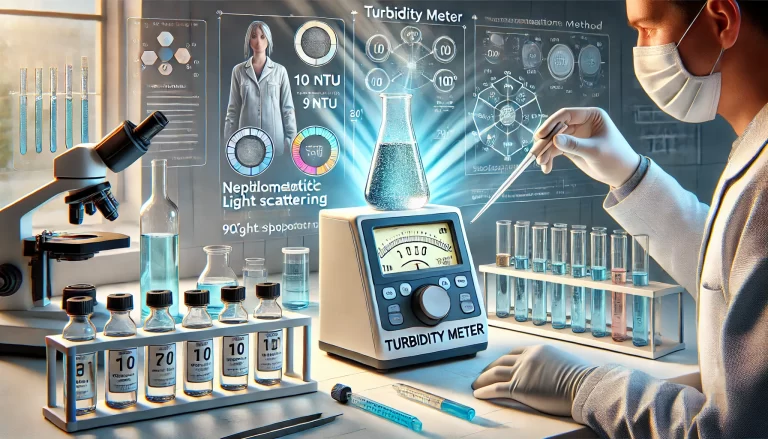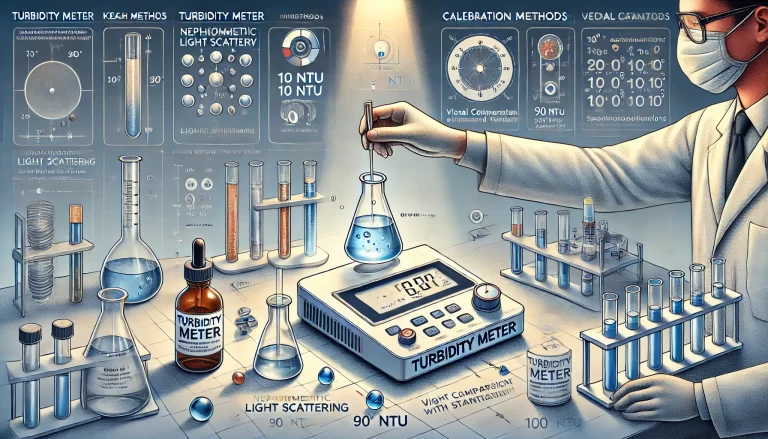1. Introduction to Turbidity Measurement
Turbidity is an essential parameter for assessing water quality, indicating the presence of suspended particles that scatter light passing through water. Turbidity meters are widely used in laboratories, industrial applications, and environmental monitoring to ensure water quality standards are met. This article explores the primary methods for measuring turbidity, calibration procedures, and best practices for accurate results.
2. Common Methods for Turbidity Measurement
2.1 Nephelometric Method (Scattered Light Method)
The nephelometric method is the most commonly used approach for measuring turbidity. In this method:
A beam of light passes through a water sample.
The meter measures the intensity of light scattered at a 90° angle by suspended particles.
The measurement is expressed in Nephelometric Turbidity Units (NTU).
This method is highly accurate for detecting low levels of turbidity and is widely recognized by regulatory authorities.
2.2 Comparison with Standard Solutions (Turbidimetric Method)
In this method, water samples are compared with prepared turbidity standard solutions (e.g., kaolin or formazin suspensions). Key features include:
A standard solution is prepared by adding 1 mg of silica dioxide to one liter of distilled water (1 NTU standard).
The sample’s turbidity is visually compared or measured against the standard solution.
While practical, this method may lack precision for extremely low or high turbidity levels.
2.3 Spectrophotometric and Colorimetric Methods
These methods measure the reduction in light transmission caused by suspended particles:
Spectrophotometers measure the attenuation of light intensity as it passes through the sample.
However, these methods are prone to interferences from sample color and particle absorption.
It is important to note that these methods are not universally accepted by regulatory standards for turbidity measurements.

3. Calibration Procedures for Turbidity Meters
Accurate calibration is essential to ensure reliable turbidity readings. Below are the recommended steps for calibrating a turbidity meter:
3.1 Pre-Calibration Preparation
Inspect the Standard Plates: Check the calibration standard plates for dust, stains, or smudges. Clean them using a soft lint-free cloth soaked in a 50:50 mixture of ethanol and ether.
Clean the Sample Cuvettes: Wash sample cuvettes with a mild detergent, rinse with distilled water, and dry with a soft cloth.
Warm Up the Instrument: Turn on the turbidity meter and allow it to warm up for at least 10 minutes.
3.2 Zero Calibration
Set the instrument to the ‘Zero’ range.
Place an empty sample cell (or clean water) in the instrument’s optical path.
Adjust the zero calibration knob until the display reads zero.
3.3 Calibration with Standard Solutions
Insert a certified NTU standard solution (e.g., 1 NTU, 10 NTU, or 100 NTU) into the sample holder.
Adjust the calibration knob to match the NTU value indicated on the standard solution bottle.
Avoid re-adjusting the calibration knob once set.
3.4 Measurement Verification
Measure a secondary NTU standard solution to verify the accuracy of the calibration.
If discrepancies arise, repeat the calibration steps.
4. Proper Usage of Turbidity Meters
To ensure consistent and reliable measurements, follow these usage guidelines:
Sample Preparation: Use clean and clear sample cuvettes.
Range Selection: Select the appropriate range (e.g., 1 NTU, 10 NTU, or 100 NTU) based on sample turbidity levels.
Avoid Air Bubbles: Remove any air bubbles in the sample as they can distort readings.
Calibration Verification: Regularly verify calibration with standard solutions.
Repeat Measurements: Perform multiple measurements and calculate an average for accuracy.

5. Limitations and Interferences
Color Interference: Colored samples can absorb light and affect readings.
Particle Size Variation: Large or irregularly shaped particles can cause inconsistent scattering patterns.
Instrument Variability: Different instruments may provide slightly varied results due to calibration differences.
6. Conclusion
Turbidity meters are invaluable tools for water quality monitoring when used correctly and calibrated regularly. The nephelometric method remains the gold standard due to its precision and regulatory acceptance. By following proper calibration procedures and operational guidelines, users can ensure accurate and reliable turbidity measurements across various applications.
This guide serves as a comprehensive resource for understanding turbidity measurement and enhancing best practices in calibration and usage.
